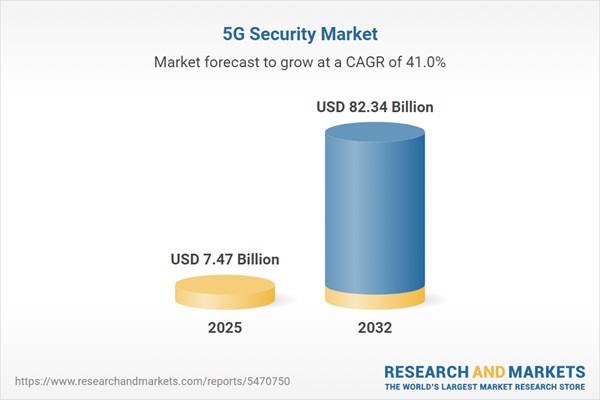Speak directly to the analyst to clarify any post sales queries you may have.
The 5G security market is fundamentally elevating the standards of enterprise risk management, compelling organizations to reassess how they protect interconnected digital environments and critical assets in the face of increased network complexity and emerging threats.
Market Snapshot: 5G Security Market Size and Projected Growth
In 2024, the global 5G security market achieves a valuation of USD 5.26 billion, with projected expansion to USD 82.34 billion by 2032, representing a compound annual growth rate of 41.00%. Enterprise investment in advanced cyber defense, a heightened focus on digital transformation, and growing demand for integrated security solutions are fueling this acceleration. Key industries such as finance, healthcare, and manufacturing are deploying cutting-edge capabilities to keep pace with evolving compliance needs, outpace increasingly sophisticated cyber threats, and strengthen operational reliability within ever-evolving network infrastructures.
Scope & Segmentation of the 5G Security Market
- Component: Security appliances and specialized chipsets, consulting services, dynamic risk assessment tools, and adaptable solutions comprise the backbone of security systems designed for both established and modern IT environments.
- Implementation Tools: Application, cloud, endpoint, and network security platforms equip organizations with comprehensive threat management, allowing for rapid detection and deployment across hybrid and cloud-first infrastructures.
- Service Type: Consulting, compliance advisory, risk evaluation, and managed detection facilitate the identification of vulnerabilities and alignment with changing regulatory mandates.
- Security Type: API protection, web firewalls, cloud access security brokers, workload security, encryption, key management, endpoint monitoring, multi-factor authentication, VPNs, analytics, and threat intelligence enable holistic risk coverage across networks and distributed cloud assets.
- End User: Banking and financial services, government agencies, healthcare entities, manufacturers, retailers, and telecom operators rely on tailored solutions for domain-specific privacy and compliance needs.
- Deployment Mode: Non-standalone and standalone methods offer flexibility for incremental upgrades or full modernization of current infrastructure.
- Regional Coverage: Americas, Europe, Middle East & Africa, and Asia-Pacific present diverse digital maturity levels and regulatory frameworks, shaping market demand and solution customization.
- Companies Analyzed: Cisco Systems, Huawei Technologies, Ericsson, Nokia Corporation, Fortinet, Palo Alto Networks, Check Point Software Technologies, Juniper Networks, ZTE Corporation, and F5 Networks contribute to industry development with sophisticated products and responsive solutions for complex operational demands.
Key Takeaways: Strategic Insights for Senior Decision-Makers
- Continuous updates to security frameworks are essential for maintaining strong governance as digital ecosystems evolve rapidly.
- Routine protocol enhancement and adaptive controls are crucial for securing IoT devices and connected infrastructures, delivering necessary risk mitigation as exposure grows.
- Automation, artificial intelligence, and strong encryption technology support timely incident response and streamline compliance across expanding enterprise environments.
- Technology vendors, telecom operators, and regulators must work together to build coordinated defenses against complex, cross-border threats, reinforcing sector resilience and agility.
- Adapting security strategies to regional and sector-specific requirements ensures efficiency and supports compliance with unique privacy mandates.
- Collaboration with experienced systems integrators assists in rapid adaptation and targeted risk reduction amid shifting threat landscapes.
Tariff Impact: Trade Policy and Supply Chain Disruption
Recent changes in U.S. trade policy have increased procurement costs for 5G security hardware and caused disruptions to established supply chains. Organizations are mitigating these challenges by diversifying suppliers, investing in domestic manufacturing, and placing greater emphasis on software-driven security solutions. These strategies support operational flexibility, enhance supply chain resilience, and enable proactive risk management for navigating shifting geopolitical and market landscapes.
Methodology & Data Sources
This analysis integrates insights from executive interviews, expert consultations, and regulatory reviews, together with proprietary research and in-depth validation with senior enterprise leaders. The approach ensures actionable, realistic guidance for technology risk management planning within the 5G security sector.
Why This Report Matters
- Provides senior decision-makers with practical direction to adapt 5G security strategies for changing regulatory and business requirements.
- Empowers organizations to strengthen supply chain resilience, respond to new regulatory shifts, and incorporate continuity measures into technology planning.
- Enables flexible, actionable planning for addressing risks arising from rapidly transforming digital environments.
Conclusion
Effective security management within the 5G landscape relies on continuous adaptation, collaboration, and precise planning to counter threats, secure operations, and maintain steady business growth amid ongoing digital change.
Additional Product Information:
- Purchase of this report includes 1 year online access with quarterly updates.
- This report can be updated on request. Please contact our Customer Experience team using the Ask a Question widget on our website.
Table of Contents
3. Executive Summary
4. Market Overview
7. Cumulative Impact of Artificial Intelligence 2025
List of Figures
Companies Mentioned
The companies profiled in this 5G Security market report include:- Cisco Systems, Inc.
- Huawei Technologies Co., Ltd.
- Telefonaktiebolaget LM Ericsson
- Nokia Corporation
- Fortinet, Inc.
- Palo Alto Networks, Inc.
- Check Point Software Technologies Ltd.
- Juniper Networks, Inc.
- ZTE Corporation
- F5 Networks, Inc.
Table Information
| Report Attribute | Details |
|---|---|
| No. of Pages | 191 |
| Published | November 2025 |
| Forecast Period | 2025 - 2032 |
| Estimated Market Value ( USD | $ 7.47 Billion |
| Forecasted Market Value ( USD | $ 82.34 Billion |
| Compound Annual Growth Rate | 41.0% |
| Regions Covered | Global |
| No. of Companies Mentioned | 11 |









